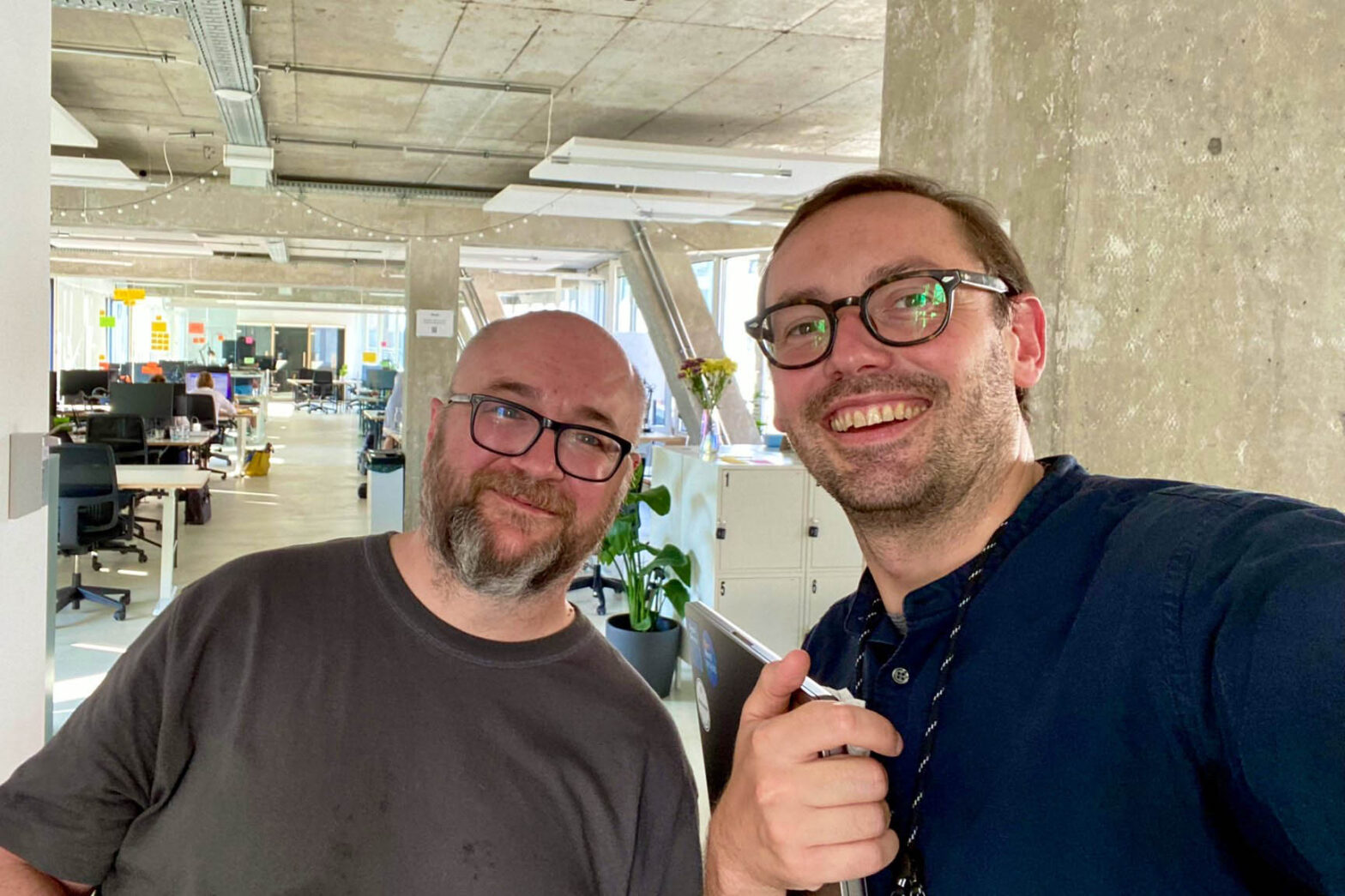This week, Matt Jukes visited, and we had time to chat in our office. He’s on a cross-European interrail trip between jobs and stopped between Hamburg and Prague. Matt has worked in the UK Civil Service and for the wider public sector for over a decade. He has worked as a consultant and a Civil Servant and will soon be coming back in-house. An extra public service he’s offering is his little weekly jobs newsletter, ‘public service internet jobs’.
Among other things, we talked about digital capability, governance and the overlapping professions, namely product management and service design. We could have spent much more time and gone more profound, but it was another 34 degrees-day, and we were both a bit done on a late afternoon.
He left me with a good sentence, though: “Internationally, let’s not repeat the same stupid things—better try new stupid things.”
Laura thinks it should go on a sticker:
And so we took it to Twitter again to create a sketch.
Communicating visually
Talking about stickers, Nadine gave me a ‘pizza-powered accessibility check’ sticker, which I earned some weeks ago. We should get into organising the next session soon.
A colleague wondered the other day if stickers are only relevant for people going to the office. I don’t think so. Stickers are visual reminders of our culture, values and attitudes. And they can display achievements.
Just by having the accessibility check sticker on my laptop and seeing it – whether it’s fully conscious or not – I can be reminded of our accessibility efforts and put those back on top of my list.
Showing our culture and making it visible matters. The original ‘It’s ok to’ poster from Giles and Sonja remains a powerful example. Posters like this are for ourselves and peers, but they also convey an important message to visiting stakeholders and future employees.
This week, we got access to the newly refurbished 4th floor of our building. And, for the first time, there is sufficient wall space to put up some posters. Daphne and I had a closer look around and want to have some messages up in the coming weeks. Starting with our mission and strategic goals seems like a good first step.
Taking long-term views
Related to this, I got involved in a review of our mission – or rather our mission path. As part of a new little work stream, a few colleagues and I are trying to understand what it takes to get “to a digital Germany” and what it might look like. So in the coming weeks, we’ll review the insights and learnings of almost 2 years and close to a dozen projects, conduct desk research, and analyse studies. The work only started, and it will be a bit messy at the start.
A request I received some days ago made me look backwards instead of forward. My post-graduate school, the Hasso Plattner Institute’s School of Design Thinking, reached out and asked for an alum interview. 4 questions and a thousand words made me think about what I learned there 12 years ago and how it changed my career path. The interview should get published shortly.
Understanding how we can improve the set-up of our projects, I again took things to Twitter to hear how others frame and describe the things they do before starting a Discovery into a new area of work. I received plenty of insightful responses I’ll need to dig through now.
After the pandemic didn’t only change how we work but also how we find new work, I was curious to hear if anyone went back to in-person and face-to-face interviews. I don’t believe we will. Too many colleagues work remotely, and it is unlikely we will be in the office simultaneously.
This week, we had a candidate for our senior designer role visit the office. After passing all the interviews and recruitment steps and taking to 6 of us for some hours, they still had a few questions. So I thought it would be good to answer them in person and also give them an idea of how we work and what it might feel like to work at our organisation. We had an hour-long conversation, built a good rapport, and signed the contract a few hours later. Seeing each other eye to eye and getting a sense of the organisation’s vibe is vital when making literally life-changing decisions. Before, we suggested coming into the office to sign the contract, but I now think it should happen 1 step earlier.
But not everything has to happen in person. Some most excellent community work happens entirely remotely. So I wanted to hear more about it. Supporting the ‘Design System for Germany’ working group, I introduced the terrific Imran Hussain, community designer for the GOV.UK Design System. I had missed that he changed his job title from ‘community manager’ to ‘community designer’ – as he designs and shapes things, not just manages them. Imran answered countless questions and gave us a better idea of how a distributed community can be supported, organised and enabled to co-create.
“Just because you have a #DesignSystem doesn’t mean you don’t need designers any longer. You also have to offer training and share good examples before people can implement its components and know how it works.”
— Martin Jordan (he/him) ? ? (@Martin_Jordan) August 4, 2022
—@ImHuYorks on the importance of #community
I said it various times before, and I will say it many more times again: I am glad we have such active international exchange across borders.
What’s next
I will finally publish our user research blog post, which is ready to go. I will also spend some time in user research sessions, as some are scheduled for next week.

